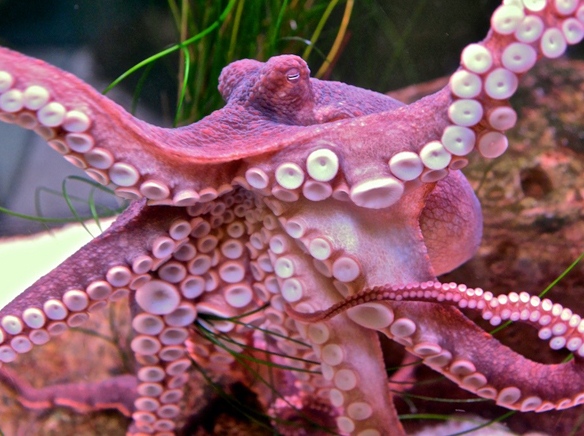By Marty Golden
Part of an ongoing series about the Seal Beach National Wildlife Refuge
One of my favorite marine animals is the California two-spotted octopus, the most common octopus in southern California. Octopus are invertebrates (critter with no skeleton), and most easily recognized by being the only marine animal with 8 legs, more appropriately called tentacles.
There are more than 300 species of octopus known in the world.
The two-spotted octopus is brownish in color and distinguished by a blue spot near each of its two eyes.
Octopus have an interesting ability to change color and texture almost instantly to mimic their background to hide from predators and help ambush their prey. Octopus are considered to be very smart and are good escape artists.
Their ability to escape from an aquarium is legendary and in at least one documented case, one went from one aquarium to another to catch prey that was not in the aquarium that they were originally in.
The octopus uses its tentacles for touch and taste. They can be used to capture prey, defend itself or to escape from an enclosure such as an aquarium.
Each tentacle has two rows of sucker cups (discs) used to help grab prey (see the photo on page 12). The two-spotted octopus is most common in shallow water, less than 15 feet deep, but reported to depths of 65 feet.
Their preferred habitat is rocky or sandy bottom, empty cans, jars, pipes or just about any object that they can hide inside.
I have seen these octopus in rocky intertidal (shore line) areas and in salt marshes like the Bolsa Chica in Huntington Beach and the Seal Beach National Wildlife Refuge. Octopus are very cryptic and usually hide in their holes (dens).
If you scan the bottom carefully you may spot a cluster of shells that often mark the opening to their den and if you are patient and still, you may see the octopus come out of their den.
The two-spotted octopus have a short life span, usually less than 2 years.
The center part (mantle) of the octopus gets to about 7 inches with tentacles growing to about 2 feet.
Baby octopus eat tiny shrimp and other small crustaceans. Adults feed on clams fish, crabs, and other small mollusks.
The greatest enemies of octopus are humans, seals, sea lions and moray eels.
To escape predators octopus have the ability to squirt out an inky substance that clouds the water (like a smoke screen) and allows them to flee.
Should you pick one up, don’t be surprised if you get inked, but do not worry the ink will not harm you. Octopus do have a beak located on their underside in the center and can bite if annoyed.
Are octopus good to eat? Yes, octopus are considered to be a delicacy.
I enjoy eating them often, usually as an appetizer.
However if you want to catch them yourself, be sure to have a fishing license and be aware that you are only allowed to use your hand (almost impossible) or hook-and-line fishing gear.
There are no size limits for octopus and there is no closed season, but there is a daily bag limit—see the California fishing regulations for the most up to date information (wildlife.ca.gov).
Marty Golden, Marine Biologist, is a member of Friends of Seal Beach National Wildlife Refuge




